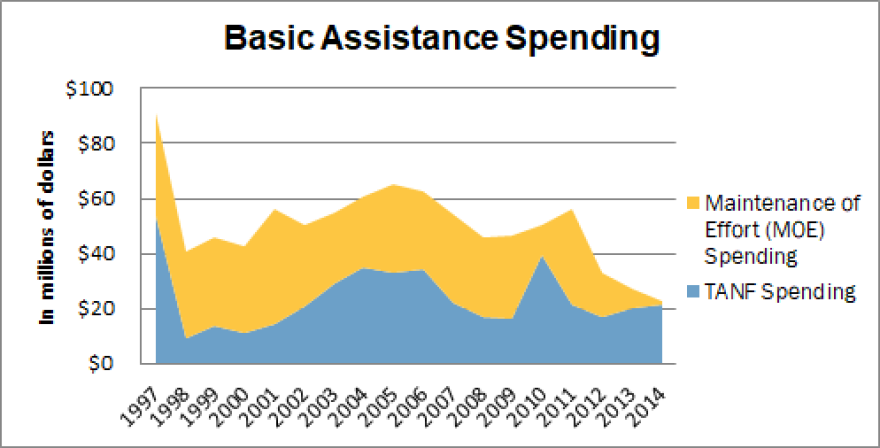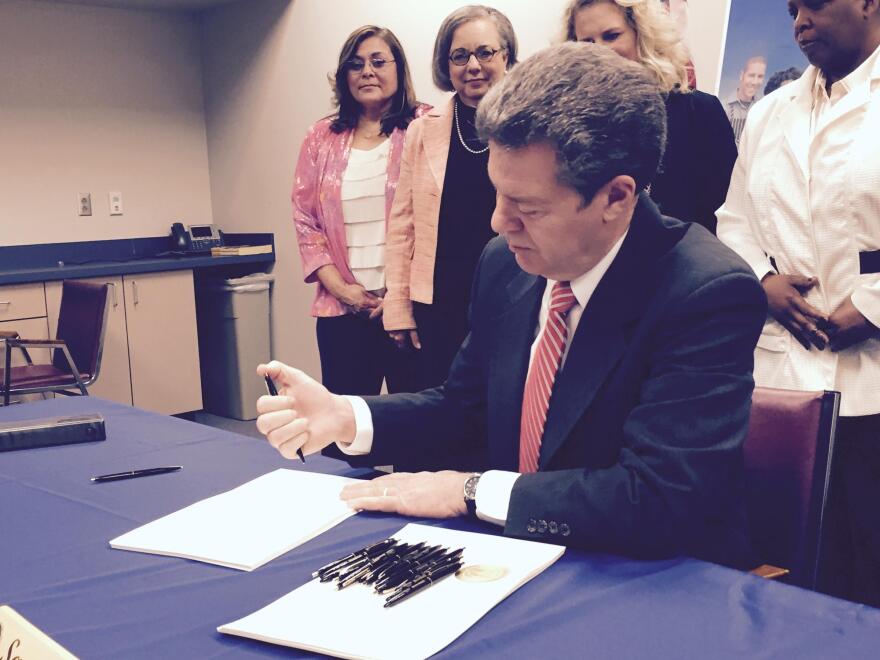If nothing else, Sam Brownback has marked his time as governor of Kansas with one bold approach after the next. And few remade the status quo as much as his approach to welfare.
That sprung from his belief that even a well-meaning government that fails to prod the poor toward self-reliance ends up creating more dependency and stubborn poverty.
Like his record on such issues as game-shifting tax cuts, the results are arguably mixed.
Still, the wins Brownback notched early in his time in office transformed state government. Even now as his influence wanes — his popularity tanked, his likely future an early exit to a Trump administration job — policy fights now all relate to what he’s put in place.
Consider his signature tax cuts. They were rolled back last year by rebellious lawmakers who fumed that the Brownback approach saddled them with a budgetary mess.
Anti-abortion laws passed in the Brownback era have survived, but they remain a source of bitter criticism from the left and a notable part of his legacy.
Then there’s welfare. In seven years, Brownback shaped cash and food assistance around his vision of self-reliance. With work requirements for Medicaid recipients now also on the table, that vision may stretch even further.
“For years, we as a country have worked at and targeted poverty and have not made any progress on it since the War on Poverty was declared,” Brownback said in the speech announcing he’d accepted a nomination to be President Trump’s ambassador for religious freedom.
Kansas, the governor said, turned another way and found success.
In Brownback’s Kansas, people are cut off from welfare more quickly. With few exceptions, every able person had to work. Other rules tightened eligibility and shifted spending away from programs that for generations had been meant for the poorest of the poor.
As a result, the Department for Children and Families pays out traditional welfare to fewer people. It also spends less of its federal grant money.
While the Brownback administration points to a sizeable drop in child poverty as the payoff, that boast draws fire.
Policy analysts and groups that advocate for the poor contend that the drop in child poverty isn’t all because of Brownback’s policies. Rather, they argue those policies could hurt Kansas’ poor down the road. Getting folks to a steady paycheck isn’t as simple as providing job training and a hard deadline and, they say, making work a requirement for welfare ignores what families need.
Temporary assistance, a push to work
One of the Republican Brownback’s most powerful tools in reshaping welfare came out of the Clinton White House. A 1996 law turned Aid to Families with Dependent Children, a federal program that matched states’ spending on cash welfare, into a block grant system. That freed states to attack poverty as they saw fit.
With the new Temporary Assistance to Needy Families, or TANF, all states had to do was put up a set amount of money to pull down tens of millions in federal grant money. In Kansas, state spending of about $65 million earns $100 million from Washington.
The money still came with strings attached. The federal and state dollars had to fit at least one of four purposes:
- Helping needy families so kids can stay in their own homes
- Reducing dependency through job preparation, work and marriage
- Preventing and reducing pregnancies out of wedlock
- Encouraging two-parent families
In return, states got more flexibility. Rulemakers in Topeka could test their own ideas about where that money went, to whom, and for how long.
The state took advantage of some of the new leeway over the years, but not until Brownback came to power did it aggressively change welfare rules.
Since 2011, Kansas has cut the total number of months a person can get TANF in their lifetime from 60 months to 24. Able-bodied adults essentially earn their welfare checks through a job, or job training, 20 or more hours a week. New mothers were exempted from working, but only for the first three months of a child’s life.
“The goal was to get people employed, and really get people out of poverty — not off the (welfare) rolls,” said Dan Decker, assistant director of employment services at the Department for Children and Families. DCF oversees Kansas’s TANF programs.
Decker said the employment push worked. DCF received some 44,000 reports of new employment from individuals receiving TANF. What people are gaining with those new jobs, he said, is “that value to yourself, that value to the community, through employment.”
Some of those still collect welfare, many don’t. But the overall number of families receiving TANF fell from about 15,000 to roughly 5,000.
Now many of those Kansas families don’t just have wage earners, they’re climbing out of poverty. Child poverty in Kansas fell from 19 percent in 2011 to 14 percent in 2016. Nationally, the rate fell from 23 percent to 19 percent in that period.
“Throwing people off the bus”
Brownback’s critics saw his approach to welfare reform as short-sighted.
Child welfare advocate Annie McKay said Brownback is also taking credit for gains that don’t reflect his policies so much as national trends.
“Poverty has been going down, unemployment has been going down, all over the country. It’s called recovery from the Great Recession,” said McKay, who leads the nonprofit Kansas Action for Children. “What’s happening in Kansas is not unique.”
She worries that the welfare changes passed under Brownback could set the state up for bigger problems down the line.
McKay’s organization advocates for policies that improve kids’ lives across many measures — poverty, academic achievement, health and safety in their families. She said that as kids are disconnected from the safety net provided by state welfare services, they could begin to struggle in school, or their families might fracture, landing children in crisis.
In fact, Researchers at the University of Kansas studying the state’s changes found a preliminary correlation between shrinking welfare help and a new wave of kids flooding the state’s already overwhelmed foster care system.
Rochelle Chronister, who headed Kansas’s state welfare agency in the 1990s, said there’s “absolutely” a connection between welfare reduction and more kids needing to be pulled from troubled families.
“There are things you can do to help improve things for families,” she said “I didn't see any of those things happening (under Brownback).”
Chronister, who was a Republican lawmaker before taking over what was then the Department for Social and Rehabilitation Services, said the state should try to move welfare recipients toward employment. She wants limits on how long people can receive welfare. She thinks the five-year lifetime limit during her tenure was “about right.”
But by cutting eligibility to two years, she said the Brownback administration is “throwing people off the bus before they’re ready to take that next step.”
Disinvesting from welfare
While Brownback touts self-reliance and a work-first mentality, Kansas actually spends a smaller share of its state and federal welfare dollars on work programs than it did in 2011.

At the same time, it spends a much smaller percentage on cash assistance — those monthly payments that require 20 hours of work a week — than it did before the governor took office.
Kansas’ overall welfare spending is also down. A chunk of the money it gets from the federal government goes unspent, left in a reserve fund that the state might spend on welfare in the years to come.
Since 2011, Kansas has socked away $60 million of federal grant money, up from just $10 million when Brownback entered office.
McKay said she’s angry the state isn’t using more of that money.
“It is unconscionable to me that we are struggling as a state to meet the needs of children and families,” she said. “We are banking dollars that could be making an impact on the child welfare system.”
Meanwhile, the state shifted some welfare dollars from direct assistance to low- and moderate-income tax credits.

The Earned Income Tax Credit puts money back in the pockets of working families. Because it encourages people to work, it meets the federal standard to count as welfare spending — and it’s popular among both Republicans and Democrats.
But what most analysts consider the core of welfare — a safety net of job training, cash and child care the poorest families need during their most troubled times — doesn’t include the tax credit for the working poor.
The EITC was part of Kansas budget obligations before Brownback, and has been partially paid for using welfare money since 2001. But during Brownback's tenure, the state put an even greater percentage toward the EITC, using the bulk of its obligated state welfare money to cover the tax credit.
The reliance on EITC to comply with federal welfare rules reflects the state budget more broadly, said Liz Schott of the left-leaning national Center for Budget and Policy Priorities.
Still, the Brownback team champions Kansas as an example of how to wean people off welfare — primarily by insisting that they work.
“We believe the policies are right around TANF,” said Gina Meier-Hummel, the new head of Kansas’s welfare agency. She was tapped to lead DCF by Lt. Gov. Jeff Colyer, suggesting that Brownback’s policies might continue after his administration.
“We’ve seen great success around families getting to work.”
Editor’s note: Due to a misstatement from a source, a previous version of this story incorrectly characterized the nature of the reports of new employment to DCF. There were 44,000 reports of new employment.
Madeline Fox is a reporter for the Kansas News Service, a collaboration of KCUR, Kansas Public Radio, KMUW and High Plains Public Radio covering health, education and politics. You can reach her on Twitter @maddycfox. Kansas News Service stories and photos may be republished at no cost with proper attribution and a link back to kcur.org.




